含呋喃-吡啶单元的可溶生物基本征黑色聚酰亚胺:合成、结构和性能
IF 6.3
2区 化学
Q1 POLYMER SCIENCE
引用次数: 0
摘要
黑色聚酰亚胺(bpi)在航空航天、微电子、先进光学器件等领域具有重要的应用前景。为此,以糠醛为原料,设计并通过Hantzsch反应成功合成了3种含呋喃吡啶单元的生物基芳香二胺,即4-呋喃-2,6-(4-氨基苯基)吡啶(PFDA)、带醚键(- O-)的O- fpda和带- CF3基团的6F-FPDA。采用FT-IR、1HNMR和XRD分析对三种二胺进行了更精细的结构表征。然后,用三种二胺和邻苯二甲酸二酐(PMDA)分别缩聚制备了新型本征双酚类化合物FPPI、O-FPPI和6F-FPPI。在室温下,所有的双酚类化合物在许多极性溶剂如DMF、DMAc和DMSO中具有优异的溶解度。其中,FPPI和O-FPPI易溶于四氢呋喃(THF)等低沸点溶剂,具有较好的成形性和加工性。在N2气氛下,这些bpi也表现出优异的热稳定性。特别是O-FPPI样品,其初始热分解温度(T5)为478℃,800℃时残余碳率(Yc)超过71%。同时,所有BPI薄膜在UV-Vis区均表现出超强的光吸收。FPPI薄膜几乎具有全光谱吸收,截止波长(λcut)约为702 nm,在760 nm处的相对透过率仅为2.85%。由于这些突出的性能和生物基特性,这些具有呋喃吡啶单元的二胺在未来的可持续应用中可以为bpi提供绿色可再生和易于获得的原料。本文章由计算机程序翻译,如有差异,请以英文原文为准。

Solvable bio-based intrinsic black polyimides containing furanyl-pyridine units: synthesis, structures and properties
Black Polyimides (BPIs) have very important prospectives in aerospace, microelectronics, and advanced optical devices. To the aim, three bio-based aromatic diamines containing furanyl-pyridine units, such as 4-furanyl-2,6-(4-aminophenyl)pyridine (PFDA), O-FPDA with ether bond (−O-) and 6F-FPDA with −CF3 groups, were designed and successfully synthesized via the Hantzsch reaction using the furfural as original materials. More fine structures of three diamines were determined by using FT-IR, 1HNMR and XRD analysis. Then, the novel intrinsic BPIs, such as FPPI, O-FPPI and 6F-FPPI, were prepared by polycondensation between three diamines and pyromellitic dianhydride (PMDA), respectively. All BPIs exhibit excellent solubility in many polar solvents such as DMF, DMAc, and DMSO at room temperature. Among them, FPPI and O-FPPI are easily dissolved in low-boiling point solvents such as tetrahydrofuran (THF), which would provide the better formability and processability. Under N2 atmosphere, these BPIs also show the outstanding thermal stability. Especially, O-FPPI sample displays the initial thermal decomposition temperature (T5) of 478 °C and the residual carbon rate (Yc) of over 71 % at 800 °C. Meanwhile, all BPI films exhibit the super-strong light absorption in UV–Vis districts. FPPI film has almost full spectrum absorption, with the cutoff wavelength (λcut) about 702 nm and the relative transmittance only of 2.85 % at 760 nm. Due to these outstanding properties and bio-based characteristics, these diamines with furanyl-pyridine units could provide the green renewability and easy availability of raw materials for BPIs in the future sustainable applications.
求助全文
通过发布文献求助,成功后即可免费获取论文全文。
去求助
来源期刊

European Polymer Journal
化学-高分子科学
CiteScore
9.90
自引率
10.00%
发文量
691
审稿时长
23 days
期刊介绍:
European Polymer Journal is dedicated to publishing work on fundamental and applied polymer chemistry and macromolecular materials. The journal covers all aspects of polymer synthesis, including polymerization mechanisms and chemical functional transformations, with a focus on novel polymers and the relationships between molecular structure and polymer properties. In addition, we welcome submissions on bio-based or renewable polymers, stimuli-responsive systems and polymer bio-hybrids. European Polymer Journal also publishes research on the biomedical application of polymers, including drug delivery and regenerative medicine. The main scope is covered but not limited to the following core research areas:
Polymer synthesis and functionalization
• Novel synthetic routes for polymerization, functional modification, controlled/living polymerization and precision polymers.
Stimuli-responsive polymers
• Including shape memory and self-healing polymers.
Supramolecular polymers and self-assembly
• Molecular recognition and higher order polymer structures.
Renewable and sustainable polymers
• Bio-based, biodegradable and anti-microbial polymers and polymeric bio-nanocomposites.
Polymers at interfaces and surfaces
• Chemistry and engineering of surfaces with biological relevance, including patterning, antifouling polymers and polymers for membrane applications.
Biomedical applications and nanomedicine
• Polymers for regenerative medicine, drug delivery molecular release and gene therapy
The scope of European Polymer Journal no longer includes Polymer Physics.
 求助内容:
求助内容: 应助结果提醒方式:
应助结果提醒方式:


